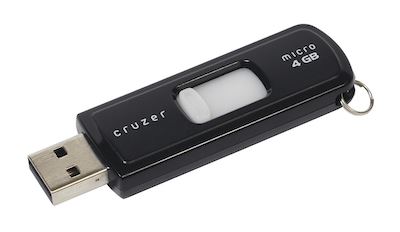The following is a Plus Edition article written by and copyright by Dick Eastman.
 Flash drives have generally replaced CD-ROM disks, DVD-ROM disks, Blu-Ray disks, floppy disks, magnetic tape, and even old-fashioned punch cards as the preferred method of storing backup copies of computer data. Indeed, these tiny devices are capable of storing as much as 1 terabyte (1,000 gigabytes) of data for reasonable prices. ("Reasonable prices" are defined as prices that are lower than purchasing equivalent storage capacity on CD-ROM, DVD-ROM, and Blu-Ray disks.) If history repeats itself again, even today's unreasonably-priced high-capacity flash drives will be even cheaper within a very few years.
Flash drives have generally replaced CD-ROM disks, DVD-ROM disks, Blu-Ray disks, floppy disks, magnetic tape, and even old-fashioned punch cards as the preferred method of storing backup copies of computer data. Indeed, these tiny devices are capable of storing as much as 1 terabyte (1,000 gigabytes) of data for reasonable prices. ("Reasonable prices" are defined as prices that are lower than purchasing equivalent storage capacity on CD-ROM, DVD-ROM, and Blu-Ray disks.) If history repeats itself again, even today's unreasonably-priced high-capacity flash drives will be even cheaper within a very few years.
Flash drives are often used for the same purposes for which floppy disks or CDs were used in the past, i.e., for storage, data back-up, and transfer of computer files. They are smaller, faster, have thousands of times more capacity, and are more durable and reliable, mostly because they have no moving parts. Additionally, they are immune to electromagnetic interference (unlike floppy disks), and are unharmed by surface scratches (unlike CDs).
One question arises however: will the data stored on flash drives still be readable in a few years? A second question also arises: "How many times can I write to a flash drive before it becomes unusable?"
Wikipedia offers a simple statement about flash drive life expectancies at http://en.wikipedia.org/wiki/USB_flash_drive:
“The memory in flash drives was commonly engineered with multi-level cell (MLC) based memory that is good for around 3,000-5,000 program-erase cycles. Nowadays Triple-level Cell (TLC) is also often used, which has up to 500 write cycles per physical sector, while some high-end flash drives have single-level cell (SLC) based memory that is good for around 30,000 writes.[ There is virtually no limit to the number of reads from such flash memory, so a well-worn USB drive may be write-protected to help ensure the life of individual cells.
"Estimation of flash memory endurance is a challenging subject that depends on the SLC/MLC/TLC memory type, size of the flash memory chips, and actual usage pattern. As a result, a USB flash drive can last from a few days to several hundred years.”
The word "can" in that statement makes me uncomfortable. Will the flash drive I am using allow that many read/write cycles, or is mine one of the flash drives that is included in the statement “a USB flash drive can last from a few days?.” Will my device last 10 years if left on the shelf, or will it have a life expectancy of much less than 10 years? Also, how many read/write cycles will I consume in normal use?
The remainder of this article is reserved for Plus Edition subscribers only. If you have a Plus Edition subscription, you may read the full article at: https://eogn.com/(*)-Plus-Edition-News-Articles/10414844.
If you are not yet a Plus Edition subscriber, you can learn more about such subscriptions and even upgrade to a Plus Edition subscription immediately at https://eogn.com/page-18077.